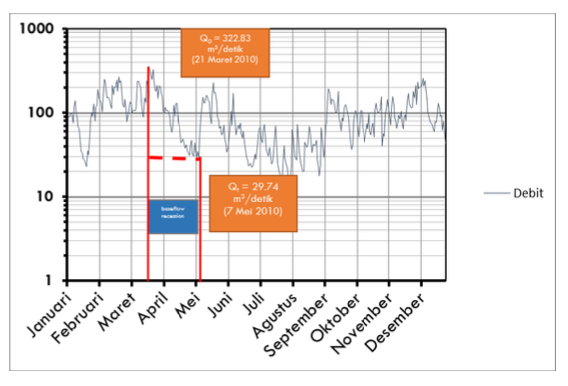Estimasi Imbuhan Airtanah Dan Groundwater Storage Berdasarkan Perhitungan Metode Baseflow Recession Pada Cekungan Airtanah Bandung-Soreang, Jawa Barat
Keywords:
Citarum Watershed, groundwater, BaseflowAbstract
Water is a necessity that is inseparable from a living being. Until now, water needs have continued to increase in line with the rapid growth of the human population. But the water needs are not comparable to existing water resources. As a result, in some cases there are droughts and shortages of water resources. Bandung-Soreang Groundwater Basin is a Groundwater Basin that covers many areas namely, Bandung Regency, part of West Bandung Regency, part of Sumedang Regency, Cimahi City and Bandung City. The Bandung-Soreang Groundwater Basin has a watershed that covers almost the entire area of this basin, namely the Upper Citarum Watershed. The Upper Citarum Watershed plays an important role in the sustainability of the groundwater system in this basin. The estimation of groundwater potential and recharge in the Bandung-Soreang Groundwater Basin uses an approach of groundwater potential and recharge from the Upper Citarum Watershed. The Baseflow Recession method is applied to calculate the potential for groundwater and recharge. The data used in this method is the daily flow data of the Citarum River in series from 2010 until 2017. Based on the calculation of baseflow reseccion, the potential of groundwater in the Upper Citarum watershed is around 265,648,903.66 m3. Meanwhile, the average annual recharge is 146.57 mm / year. The value of groundwater potential and recharge in an area is controlled by several factors including climatic conditions, topography, geology, vegetation, geomorphology and land use. In an effort to maintain the function of the Upper Citarum Watershed as a natural and potential conservation area, there are several steps that should be taken, namely technological engineering and vegetatif methods. For example, technological engineering can made recharge wells and vegetatif methods can include reforestation in watershed areas
References
Alzwar, M. A., & Bachri, S. (1992). Peta Geologi Lembar Garut dan Pameungpeuk, Jawa, Skala 1:100.000. Bandung: Pusat Penelitian dan Pengembangan Geologi.
Bronto, S., & dkk. (2004). Penelitian Awal Mineralisasi di Daerah Cupunagara, Kab. Subang-Jawa Barat. Majulah Geologi Indonesia, Vol. 19, No. 1, Hal. 12-30.
Bronto, S., & Hartono, U. (2006). Potensi Sumber Daya Geologi di Daerah Cekungan Bandung dan sekitarnya. Jurnal Geologi Indonesia, Vol.1 No.1, 9-18.
Charles, W. F. (2001). Applied Hydrogeology. Prentice Hall.
Chow, V. (1988). Applied Hydology.
DAM, M. A. (1994). The Late Quartenary Evolution of the Bandung Basin, West Java, Indonesia. Amsterdam: Thesis Vrije Universitiet.
Domenico, P. A., & Schwartz, F. W. (1990). Physical and Chemical Hydrogeology. New York: Geological Megazine.
Hadisantono, R. D. (1988). Same aspects of the nature and origin of the widespread pyroclastic flow deposits surrounding Tangkuban Perahu, Bandung, West Java. New Zealand: Msc Thesis, Victoria Univ. of Wellington.
Hutasoit, L. M. (2009). Kondisi Permukaan Air Tanah dengan dan tanpa peresapan buatan di daerah Bandung: Hasil Simulasi Numerik. IJOG, Vol 4 No.3.
Irawan, D. E. (2009). Hidrogeologi Cekungan Bandung. In GEOLOGI CEKUNGAN BANDUNG (pp. Bagian ke-12).
Karmadi, M. A. (2019). PENENTUAN KOEFISIEN IMBUHAN (RC) AIR TANAH. Jurnal Teknologi, Vol. II, Edisi 34, 33-52.
Katili, J. A., & Sudrajat, A. (1984). Galunggung. Volcanological Survey of Indonesia, 102. 46
Lumbanraja, P. (2014). Menciptakan Fungsi Resapan Air Pada Daerah Budaya (Suatu konsep untuk mendukung metoda pengelolaan DAS secara terpadu, dengan pertimbangan aspek perubahan iklim dan hidrologi dalam pengelolaan DAS). MEDAN: UNIVERSITAS SUMATERA UTARA.
Maria, R., & Lestiana, H. (2014). Pengaruh Penggunaan Lahan Terhadap Fungsi Konservasi Airtanah di Sub DAS Cikapundung. Riset Geologi dan Pertambangan Vol.24, No. 2, 77-89.
PerMen ESDM. (2017). No.2 Tahun 2017 tentang Cekungan Air Tanah. ESDM.
Pertamina. (1998). Geokronologi dan Evolusi Volkanik Daerah Wayang-Windu, Jawa Barat. Geothermal Devission, 81.
Silitonga, P. H. (1973). Peta Geologi Lembar Bandung, Jawa, Skala 1:100.000. Bandung: Direktorat Geologi.
Sudjatmiko. (1972). Peta Geologi Lembar Cianjur, Jawa, skala 1:100.000. Bandung: Direktorat Geologi.
Sumawijaya, N. (2011). IMBUHAN BUATAN : SOLUSI UNTUK MENGATASI MASALAH KEKURANGAN AIRTANAH DI CEKUNGAN BANDUNG. Riset Geologi dan Pertambangan Vol. 21 No.2, 61-71.
Sunardi, E., & Koesoemadinata, R. P. (1999). New K-Ar Ages and The Magmatic Evolution of the Sunda-Tangkuban Perahu Volcano Complex Formation, West Java, Indonesia. 28th Annual Convention (pp. 63-71). Jakarta: IAGI.
The USGS Water Science School. (2019, Oktober 16). USGS. Retrieved from usgs.gov
Todd, D. K. (1959). Groundwater Hydrology.

Downloads
Posted
License
Copyright (c) 2020 Author retains copyrights under CC-BY license

This work is licensed under a Creative Commons Attribution 4.0 International License.

